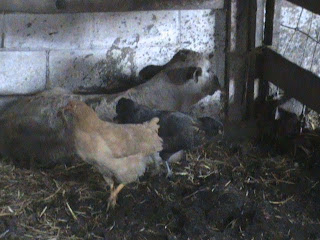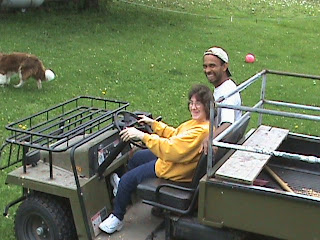I had a nice visit with our conventional pesticide and fertilizer supplier dude earlier today. I’m sure he has a title, but I have no idea what is is. So pesticide and fertilizer dude will have to do.
It was really nice to have a long talk with a farmer who’s squarely planted in the conventional world but who also doesn’t freak out and have a heart-attack when I tell them we plan to go organic. We had a long chat about different planting options, about my concerns with our ragweed problem (which wasn’t solved by the machete work), about his concerns with soil erosion in organic grain systems, and about the challenges of balancing our concerns for the environment with the economic health of the farm.
I must say it was pretty cool to receive advice about different things we could do to help us reach our goal faster, especially coming from a man who spends most of his Spring driving one of those tall, monstrous pesticide-sprayin’ vehicles that just look evil and remind me of a giant moon rover. (Not that I’ve ever seen a moon rover.)
Because I gotta tell ya, I can feel myself faltering once and awhile. It simply gets harder and harder for me to maintain one foot in the organic world and another in the conventional world. Let’s be honest. I have to constantly explain the rationale behind keeping part of the farm conventional when talking with my organic cohorts. And then I have to explain why I won’t plant GMO crops to my conventional cohorts. Especially when I see, we all see, the major weed pressure in our non-GMO fields and a simple switch to Round-Up Ready would take care of it.
I know where I want to be. I just want to be there already.
OK, I admit…patience isn’t my strongest quality. But this path in the middle is not easy. Not at all. And the worst part is that I know the longer we allow the ragweed to populate our fields, the larger the problem is going to grow. I am pretty sure that within a year or two, we’ll be at the point of no return, especially in one particular 45-acre field.
I asked Mr. fertilizer dude about planting wheat. Wheat requires less nitrogen and harvests mid-summer, which would cut back the ragweed. It also bumps up your future soybean yields, something that has lagged on our farm for years. He said the ragweed could cause a big problem with our wheat crop, though. Plus, we’d have to coninue to mow the fallow field the rest of the season if we wanted to keep the ragweeds down. Can you say diesel, diesel and more diesel?
The best option we came up with is to take that field out of row crops altogether and sock it into hay ground. We could get a premium oat-hay crop in late Spring, and then two more cuttings of Alfalfa that summer. Which means we’d mow down the ragweed 3 different times. The field could be left as hay ground for two more full summers, getting mowed 4 times each summer. Then you plow in your hay field and plant corn, which would need no nitrogen since the alfalfa provided it for us. Follow that with a year of soybeans and then back into alfalfa for three more years.
And maybe, just maybe, after three more years our cattle herd might be at the size that we’d need the land for grazing. So we wouldn’t even need to put it back into corn or soybeans.
Hmmn. Hmmn. Hmmn.
The only teensy-weensy miniscule problem I can find with this new little seed of a plan is this: we’d have about 95 acres of hay to cut, dry and bale next year!!!!! And you’all know that cutting, drying and baling hay without it getting rained on isn’t an easy task. It isn’t an easy task when your dealing with 42 acres. Add another 40-odd acres and what do you get? A stressed-out farmer, that’s what you get!!
Guess I’ve got me some thinking to do. And guess I gotta consult with the family.
Let’s see. What should I bring up first? My great idea on how to get rid of our ragweed problem? Or the fact that we might be hayin’ on 95 acres next year?
If you have any advice, this is the time to cough it up. Unless you’re the conventional-judgemental type or the organic-judgemental type. Then you can just keep it to your nice little self. Thanks in advance.

























